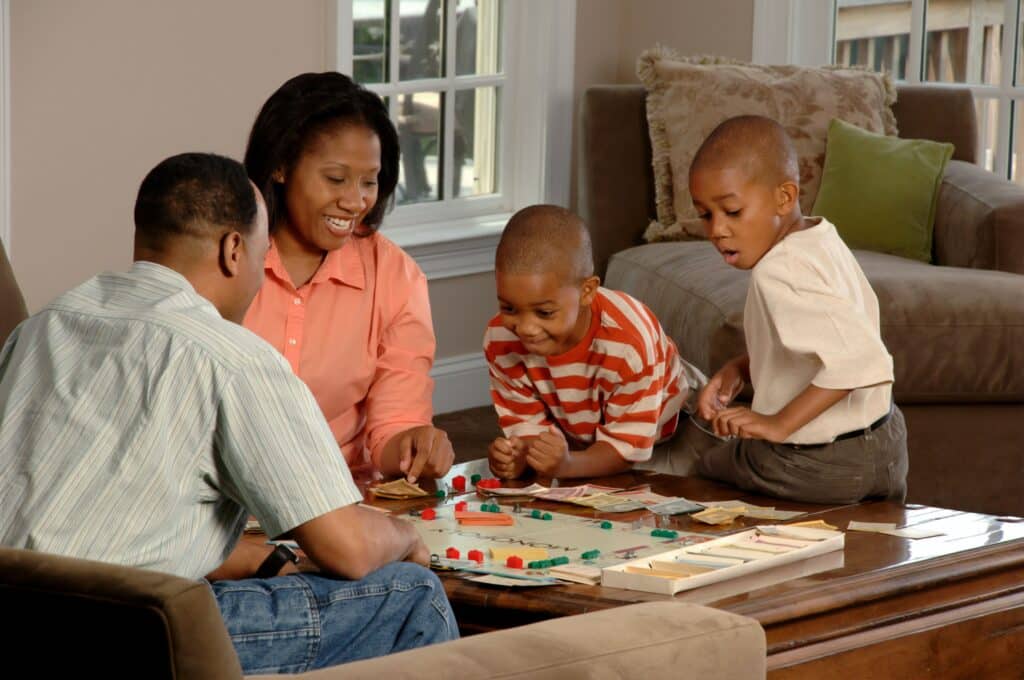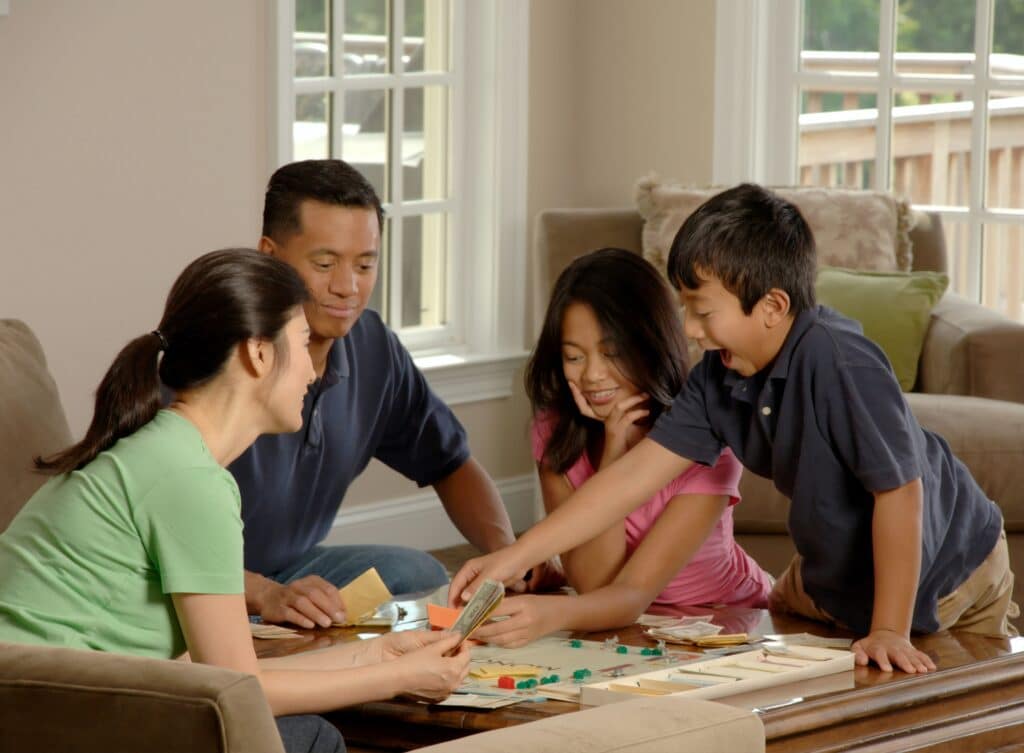
Calling all Trivial Pursuit fans! Did you know that there’s a version of the game made specifically with families in mind? That’s right: it’s called Trivial Pursuit Family Edition, and we’re here to tell you how to play it correctly.
The defining feature of Trivial Pursuit Family Edition is its kid-friendly questions. Half of the game’s trivia cards are filled with questions that are written with children in mind. This way, the game isn’t mismatched in terms of difficulty levels, and every player can answer questions that are suited to their mental age.
Below, we at Trivia Bliss have outlined the instructions for Trivial Pursuit Family Edition. We’ll go over all of the steps you’ll need to complete to play a good game. We’ll also answer some frequently asked questions regarding the game and discuss whether or not the game will be a good fit for you.
Keep reading to find out all there is to know about Trivial Pursuit Family Edition. A fun-filled game awaits!
- Features cards for kids and cards for adults
- Includes over 1,400 trivia questions
- Includes over 1,400 trivia questions
- Quick play trivia for the whole family
1. Set Up the Game Board

Before starting the game, you’ve got to set up the board and game pieces. Trivial Pursuit Family Edition comes with quite a few important pieces. In addition to the fold-out board, there are six game pieces (called “movers”), plus six colored plastic wedges for each player, making for 36 in total. These colored wedges represent each of the six categories of the game. There are also scoring tokens for which to place the colored wedges.
Re: the aforementioned six movers, it’s important to know that, though the game’s supplies can accommodate up to six players, you can enjoy the game with as few as three people in total, making it work for smaller families. Larger families can opt to play in teams so that everyone can get in on the trivia fun.
The game box also includes cards with trivia questions and answers written on them. Half of these cards feature questions for adult players, while the remaining half of the cards have questions suited for younger players. Depending on the copyright year of Trivial Pursuit Family Edition that you purchase—a couple of different versions are available for purchase—there will be between 100 and 150 cards for each of the two age groups. No matter the size of the deck, these cards will offer plenty of entertainment for every player.
Note—the instructions for Trivial Pursuit Family Edition state that the harder questions are well suited to players that are 14 years old or older, but we think they can be a little tough for tweens! When playing with a teenager between the ages of 14 and 16, make sure they use their own discretion regarding their trivia abilities to enjoy the game to the fullest.
The physical setup of the game is pretty simple. First, lay the board on the table. Then, take each smaller item out of the game box. Next, shuffle each deck of cards. Make sure to keep the adult-level trivia cards and the kid-level cards separate so that everyone receives an appropriate challenge. Each card is labeled as a “Card for Kids” or “Card for Adults,” so it should be easy to differentiate them.
You’ll also need to organize the plastic wedges by color and give a scoring token to every player. Make sure there is one scoring token on the board per player or team so that everyone has a place to keep track of their hard-earned wedges. Lastly, have each player pick a mover of their choice to serve as their game piece. Now, you’re ready to get to the trivia.
2. Roll the Die and Move Your Piece
Now, it’s time for the players to start taking turns. All players must roll the die to decide who will take the first turn. Whoever gets the highest die roll is the one who will play first.

After determining which player goes first, the first step is to roll the die to move. Each dice roll determines how many spaces each player will travel around the board. You must move the full number of places as indicated on the die. In other words, you can’t cut your traveling short if you come across a category you want to answer midway through your turn.
3. Answer a Question
After you’ve moved your game piece, lucky you! It’s time to answer a trivia question.

Answer a question that corresponds to the color of the space that you landed on. (If you’d like to skip to what category each color signifies, scroll down). Another player will draw a card and read that category’s question from it. If you get it correctly, you receive a plastic game wedge in the color of the category. Place this piece inside of your scoring token so that you have something to show for your success.
Not every space has a category’s color on it, however. There are other spots on the board to help shake up the game and keep things interesting. Trivial Pursuit Family Edition (Amazon Exclusive) features “roll again” spaces, while the standard Trivial Pursuit Family Edition contains special player-versus-player mini-challenges. Because of this, not every player will get to answer a question on every single turn. It’s entirely dependent on where they land.
4. Rotate Taking Turns
Repeat steps two and three as you switch off which player takes their turn. Go around the table either clockwise or counterclockwise—whichever way suits your fancy! Depending on the trivia expertise of each player and the luck of each die roll, this may take a while.
5. Earn Six Wedges
In general, the object of Trivial Pursuit is to show your trivia versatility, so it’s only right that the game doesn’t move into its final stage until someone’s answered at least one question from every category correctly.
Players should continue rotating around the board playing even after one has obtained six wedges. That’s because that player still has another task ahead of them: returning to the center of the game board for one final question.
6. Travel Back to the Center
As we said, the game goes on, and the previous steps can continue, but now the player (or players!) who have six wedges of different colors must try to get back to the center space to answer their last trivia question. This is easier said than done since the game’s instructions stipulate that each player must travel the exact number of spaces the die signifies. This means that a player may pass the center instead of landing in its bounds, and they may once again have to venture back the other way, answering trivia questions as they land on them.
Once you get to the center, it’s time for that last question.
How Do You Win Trivial Pursuit Family Edition?
To win Trivial Pursuit Family Edition, you must first obtain a wedge of each color representing each category. This means you will have had to answer at least one question from each category correctly.
Once a player has one wedge of each color, it’s their time to make their way back to the center of the board. This portion of the game can be excruciating for particularly competitive players who want to clinch a win as soon as possible!
Now, here’s the kicker: to win the game, a player must answer one final question that determines it all. This question will be chosen once the player has traveled back around the board to the center spot, where all of the wedge-holding tokens lie.
The center spot contains an illustration of each colored wedge, so depending on how large your die roll was, you could land on any number of these. The color of the wedge you land on determines the category of your final question. Answer it correctly, and you’ll win the game!

Alternatively, if you get the question wrong, exit the center circle and keep playing around the board. You may eventually make it back to the center for another chance to win, but only time (and your competition!) will tell as to whether that comes to pass.
Winning Trivial Pursuit Family Edition is no small feat, especially for a kiddo. After all, the winner will have had to show their chops in all of the game’s featured categories: science and nature, geography, the arts and culture, entertainment, sports and leisure, and history. That’s a lot of trivia for a young one!
What Do the Colors Mean in Trivial Pursuit Family Edition?

As we alluded to earlier, the colors in Trivial Pursuit Family Edition indicate the different categories of the game. The categories and their colors are as follows: blue for geography, orange for sports and leisure, purple for the arts and culture, pink for entertainment, yellow for history, and green for science and nature.
These are the same colors and categories that are used in the original Trivial Pursuit. However, if you grew up with Trivial Pursuit in the ’90s or earlier, you’ll know that the category colors have changed since then. There’s no brown anymore, nor is there a wild card category, and some of the categories (science and nature and sports and leisure) have switched around their colors. If you find yourself getting tripped up by the category colors not matching up with what you remember, make sure you consult your game’s instruction booklet throughout gameplay.
What’s the Difference Between Trivial Pursuit Family Edition and “Regular” Trivial Pursuit?
Just like we mentioned earlier, the main difference between Trivial Pursuit Family Edition and “regular” Trivial Pursuit is its dual card decks. One card deck is filled with easier questions geared toward younger players, while the other is designed for adults. Some versions specify that ages 14 and up should play with the adult deck, though we believe this might be challenging for some folks that age.
Though the quantity of cards in each deck varies from edition to edition of the game, there will be an equal number of cards for kids and adults in each Trivial Pursuit Family Edition game box. This way, there will be equal opportunities for all players to answer new and novel questions that are challenging to them.
Is Trivial Pursuit Family Edition Good?
We’ve gone through the game’s instructions and intricacies, as well as how it’s different from the original Trivial Pursuit. Still, one important question remains: is Trivial Pursuit Family Edition actually good?
In short, yes! In our humble opinion, Trivial Pursuit Family Edition makes for a pretty solid play. Since it’s quite similar to the original Trivial Pursuit, you’ll most likely like it if you enjoy the former.

To better answer this question, we’ve consulted the Amazon reviews of Trivial Pursuit Family Edition. Overall, each version of the game has received an average rating of over 4.5 stars. Parents state that, though the adult questions may air on the side of being too easy, the children’s questions are perfectly suited to their kids. The reviewers seem to concur that this game is much more well-suited to families than the original Trivial Pursuit (we would hope, given its namesake!).
So, yes, Trivial Pursuit Family Edition is good. We especially recommend it for parents with kids between the ages of 8 and 12. Obviously, Trivial Pursuit Family Edition is a better play for a mix of adults and children than for one group or the other, so if you don’t have kids in your family, it’s best to opt for a different game. Why not purchase it for yourself to see how it measures up to the reviews?
Final Words
Thank you so much for reading through our guide to playing Trivial Pursuit Family Edition. We hope our explanation clarifies if the game is right for you and your family. Looking for the perfect game for your kids to play on their own? We’ve got a guide for how to play Trivial Pursuit Junior, too!

Have you played Trivial Pursuit Family Edition before? If so, what was your experience with it? How did it measure up to the original version? What other family trivia games do you enjoy? Share any of your thoughts in the comments down below.

Leave a Reply